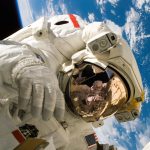Magnets Protect Astronauts from Solar Wind
A few years ago, we explored this question about how magnets could potentially protect astronauts: can magnets protect against cosmic radiation?
Now, a program between the Information Satellite Systems (ISS)-Reshetnev Company and the Siberian Branch of the Russian Academy of Sciences is conducting research on how a magnetic dipole could protect crew members from galactic and solar cosmic rays while on missions beyond Earth’s boundaries that last more than twelve months.
How the Magnetic Dipole Works
In the interplanetary environment, magnetic and solar wind flows interact and create a mini-magnetosphere. In order to calculate how much protection astronauts would need from the magnetosphere, including where they should sit in a spacecraft and what equipment they need, it’s crucial to know the shape of the magnetosphere, the areas of plasma penetration, and induced currents based on solar wind intensity. Researchers assigned to the project are determining this by mapping plasma density and speed around the magnetic dipole.
Research Goals
Ionizing radiation is a major component of the interplanetary environment, which comes at a cost for astronauts if they aren’t careful. This type of radiation is comprised of gamma rays, x-rays, and particles with enough energy to cause ionization of any medium through which it passes. Long exposure to this radiation can cause health effects such as skin burns or acute radiation syndrome. Because of these consequences, the main goal of this particular research is to help protect astronauts from solar wind—which produces the ionizing radiation—in interplanetary flights.
From 2019 to 2024, ISS-Reshetnev Company and the Siberian Branch of the Russian Academy of Sciences will be carrying out scientific, technical, and innovative research to create technologically-advanced spacecraft. This feat will be accomplished by a whole set of joint research and developments between the two organizations.
Why The Research is More Important Than Ever
An article released by NASA in April of this year discusses their current space missions. Currently, NASA mans missions on the International Space Station (ISS). Most missions are approximately 6 months, but NASA is exploring options for missions closer to the duration of a year. These missions are focused on sending humans into deep space. In other to make these space explorations happen, NASA plans to send manned missions to the moon. Their ultimate goal? Mars.
We hope the magnetic research will help make NASA’s goals a reality in the near future. We will follow this topic closely, so check back for our next follow up! In the meantime, be sure to explore our other blog posts for more articles like this one.

